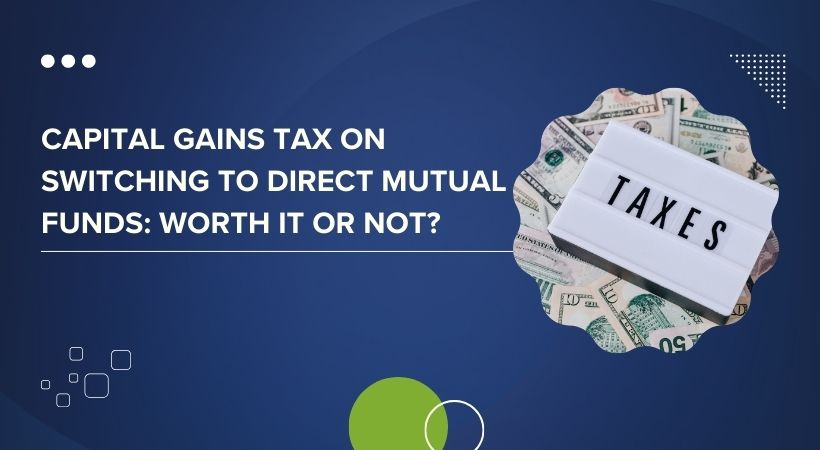The case for switching to direct mutual funds is strong: lower expense ratios, no hidden commissions, and better long-term returns. But one concern holds many investors back—capital gains tax.
“Why pay tax on something that’s already working?” they ask. While it’s a valid question, the answer often lies in doing the math and understanding how taxation works.
Let’s decode it.
What Happens When You Switch?
Switching from a regular to a direct plan is treated by the Income Tax Department as a sale of your existing fund (redemption) followed by a fresh investment in the direct plan. This triggers capital gains tax based on:
- The type of fund (equity or debt)
- The holding period (short-term or long-term)
Tax Rules for Equity Mutual Funds
Equity-oriented mutual funds are taxed as follows:
- Short-Term Capital Gains (STCG):
- Holding period: Less than 12 months
- Tax rate: 15% on gains
- Holding period: Less than 12 months
- Long-Term Capital Gains (LTCG):
- Holding period: More than 12 months
- Tax rate: 10% on gains exceeding ₹1 lakh per year
- Example: If your gain is ₹1.5 lakh, only ₹50,000 is taxed at 10%.
- Holding period: More than 12 months
In many cases, if your gain is under ₹1 lakh, you pay no tax at all.
Tax Rules for Debt Mutual Funds
Debt mutual funds follow a different set of rules, especially after changes made in 2023.
- Short-Term Capital Gains (STCG):
- Holding period: Less than 36 months
- Tax rate: As per your income tax slab
- Holding period: Less than 36 months
- Long-Term Capital Gains (LTCG)
(For funds purchased before April 1, 2023)- Holding period: More than 36 months
- Tax rate: 20% with indexation benefit
- Indexation adjusts your cost for inflation, reducing taxable gain.
- Holding period: More than 36 months
From April 1, 2023, all gains from debt funds (regardless of holding period) are taxed as per income slab, removing indexation.
Why Tax Fear Is Often Overstated
Let’s assume you invested ₹10 lakhs in an equity regular mutual fund 5 years ago, and it’s grown to ₹17 lakhs.
- Capital gain: ₹7 lakhs
- LTCG exemption: ₹1 lakh
- Taxable gain: ₹6 lakhs
- Tax @10%: ₹60,000
Now let’s compare that with the benefit of switching:
- Regular Plan (2% expense) @10% net return → ₹17L becomes ₹73.5L in 15 years
- Direct Plan (1% expense) @11% net return → ₹17L becomes ₹83.1L
- Difference: ₹9.6 lakhs gained
- Even after ₹60,000 in tax, net gain = ₹9 lakhs+
That’s a small price for a large reward.
Common Investor Fears (and Facts)
- “Switching is complicated.”
Most platforms now offer online switching. It’s easier than it sounds. - “I’ll lose my SIP track record.”
Your new direct SIP will start fresh, but your wealth creation won’t slow down. - “Tax will eat my gains.”
Only the gains are taxed, and in most long-term cases, the impact is far less than the benefit of compounding in a direct plan.
Conclusion
Capital gains tax on switching to direct mutual funds is real—but it shouldn’t be a roadblock. In many cases, especially for long-term equity investors, the tax paid today is a fraction of the wealth created tomorrow.
If your investments have matured and you’re planning to stay invested for another 10–15 years, switching to direct mutual funds may be one of the most rewarding financial moves you make.
Check your mutual fund statements. If you’re in regular plans, calculate the gains and potential tax. Compare that with the long-term benefits of lower expenses. The numbers will speak for themselves.
Author: Swapnil Kulkarni
Co-Founder, PriceBridge – A PMS of Ayan Analytics Pvt. Ltd.
With 17+ years of experience in wealth management and a nomination for the CNBC TV18 Financial Advisor Awards (2010), Swapnil Kulkarni brings deep expertise in mutual fund strategies. He is passionate about investor education and simplifying financial decisions that lead to long-term wealth creation.




